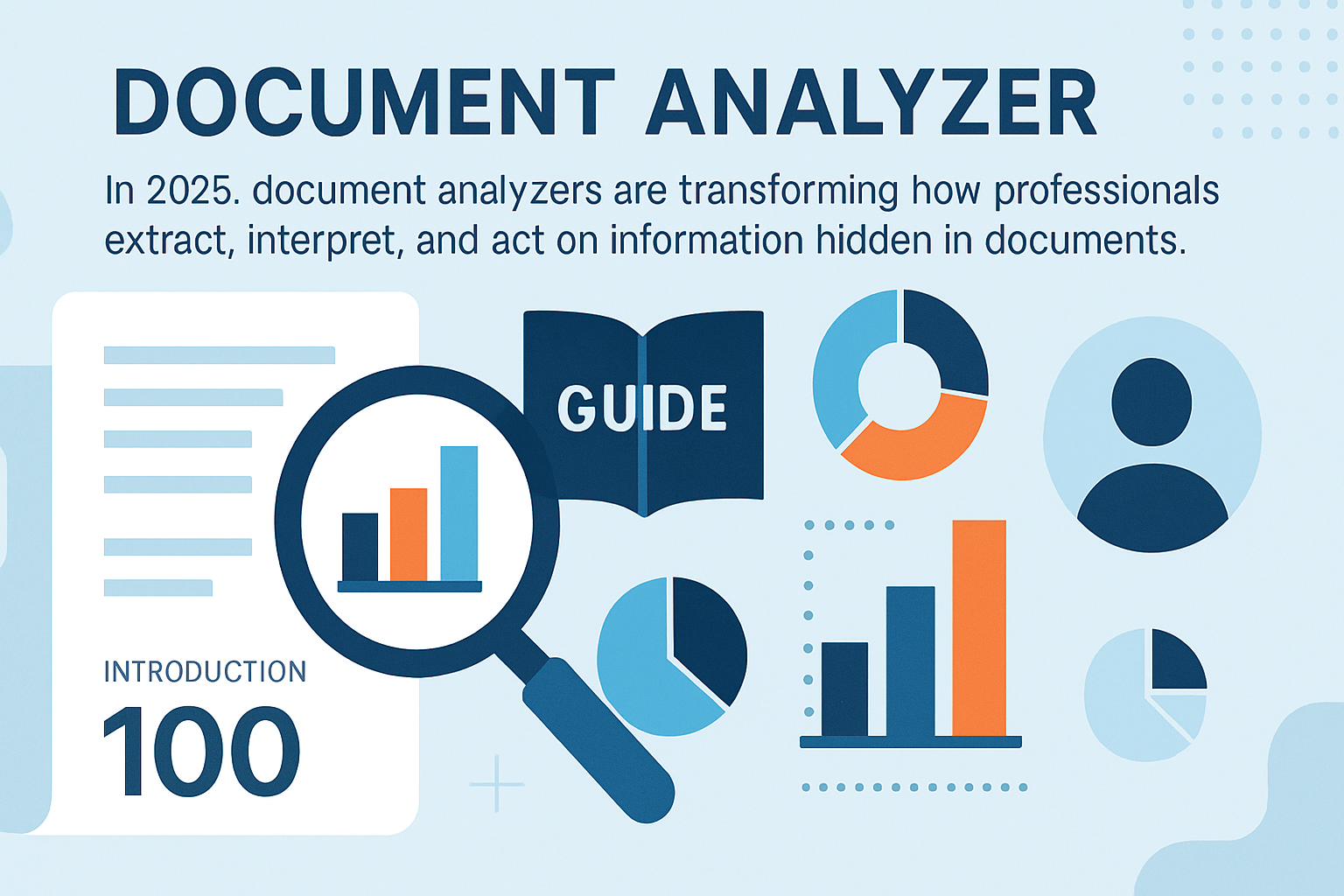In 2025, the rapid evolution of document analyzer technology is reshaping how professionals manage vital information. As digital transformation accelerates, the ability to extract, interpret, and leverage data from complex documents has never been more crucial.
This guide is designed to help you master smart document analysis, using the latest tools and strategies built for the challenges of the modern era. You'll discover what a document analyzer is, explore its essential features, follow a practical step-by-step approach, and uncover top solutions and future trends.
Ready to unlock new levels of efficiency and insight? Dive in to transform your approach and harness the true power of document intelligence.
Understanding Document Analyzers in 2025
The rapid evolution of the document analyzer is reshaping how organizations interact with their data. In 2025, professionals rely on these tools not just for digitization, but for extracting meaningful insights from massive volumes of documents. This shift is driven by the urgent need to manage information overload and stay compliant in a digital-first world.
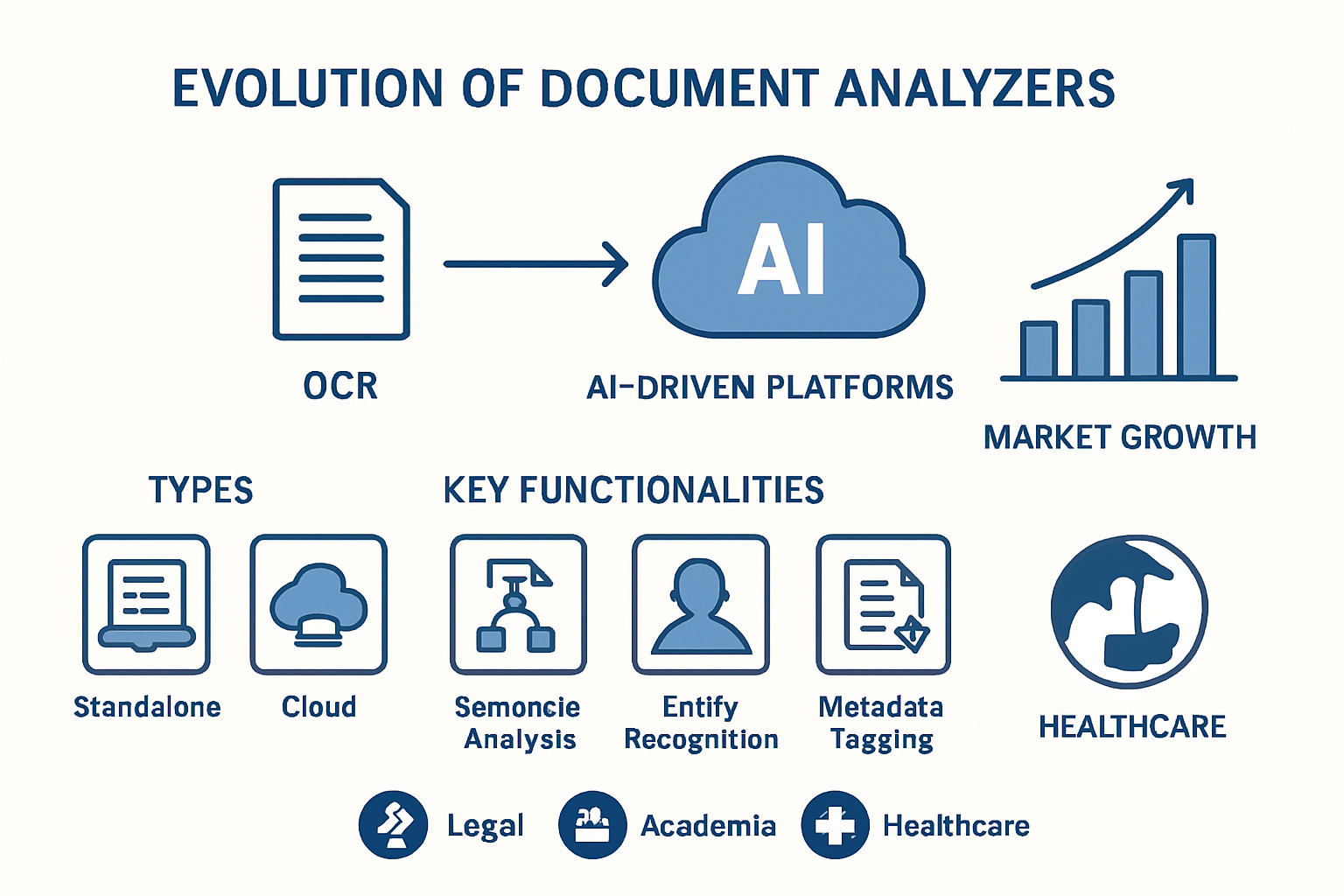
Definition and Evolution
A document analyzer is a software solution designed to extract, interpret, and organize information from various document formats. Initially, these tools focused on basic optical character recognition (OCR), converting scanned images into editable text. However, the modern document analyzer now harnesses advanced AI, enabling not just recognition but understanding of language, context, and relationships within documents.
Over the past decade, document analyzers have matured from simple text extraction utilities to sophisticated platforms capable of semantic analysis. Today, they can identify entities, detect sentiment, and tag metadata, transforming static files into actionable data.
Types and Key Functionalities
In 2025, document analyzer solutions come in several forms:
- Standalone software: Installed directly on devices for localized processing.
- Cloud-based platforms: Offer scalability, collaborative features, and remote access.
- Integrated workflow tools: Embedded within larger enterprise systems for seamless automation.
Key functionalities include:
| Functionality | Description |
|---|---|
| Text Extraction | Pulls text from PDFs, DOCX, scans, and images |
| Semantic Analysis | Understands meaning, context, and relationships |
| Entity Recognition | Identifies names, dates, clauses, and more |
| Metadata Tagging | Categorizes and labels documents for easy retrieval |
With these capabilities, a document analyzer streamlines data entry, reduces manual work, and increases accuracy in diverse environments.
AI Impact and Industry Use Cases
Artificial intelligence and machine learning have revolutionized the document analyzer, delivering unprecedented accuracy, speed, and contextual understanding. NLP models understand tone, intent, and legal risk, while machine learning algorithms continually improve with user feedback.
Industry use cases are widespread:
- Legal: Contract review and risk detection
- Business: Automated financial report analysis
- Academia: Rapid research synthesis
- Healthcare: Extraction of patient data from medical records
For example, Clio Duo leverages AI to analyze legal documents, pinpointing obligations and deadlines with high reliability.
Market Growth, Challenges, and Real-World Impact
The document analyzer market is experiencing significant growth, fueled by the explosion of digital data and regulatory demands. According to Document Analysis Market Growth Projections, industry forecasts predict robust expansion through 2033, with adoption accelerating across sectors.
These platforms address major challenges: they combat information overload, minimize manual data entry, and help organizations manage compliance risks. By automating document analysis, businesses and institutions unlock efficiency, reduce errors, and stay ahead in a fast-changing landscape.
Core Features of a Modern Document Analyzer
Modern document analyzer platforms are redefining how organizations handle information extraction, classification, and compliance. These tools bring together advanced artificial intelligence, automation, and security, making document processing faster, smarter, and more reliable than ever. Let’s break down the core features that set today’s document analyzer solutions apart.
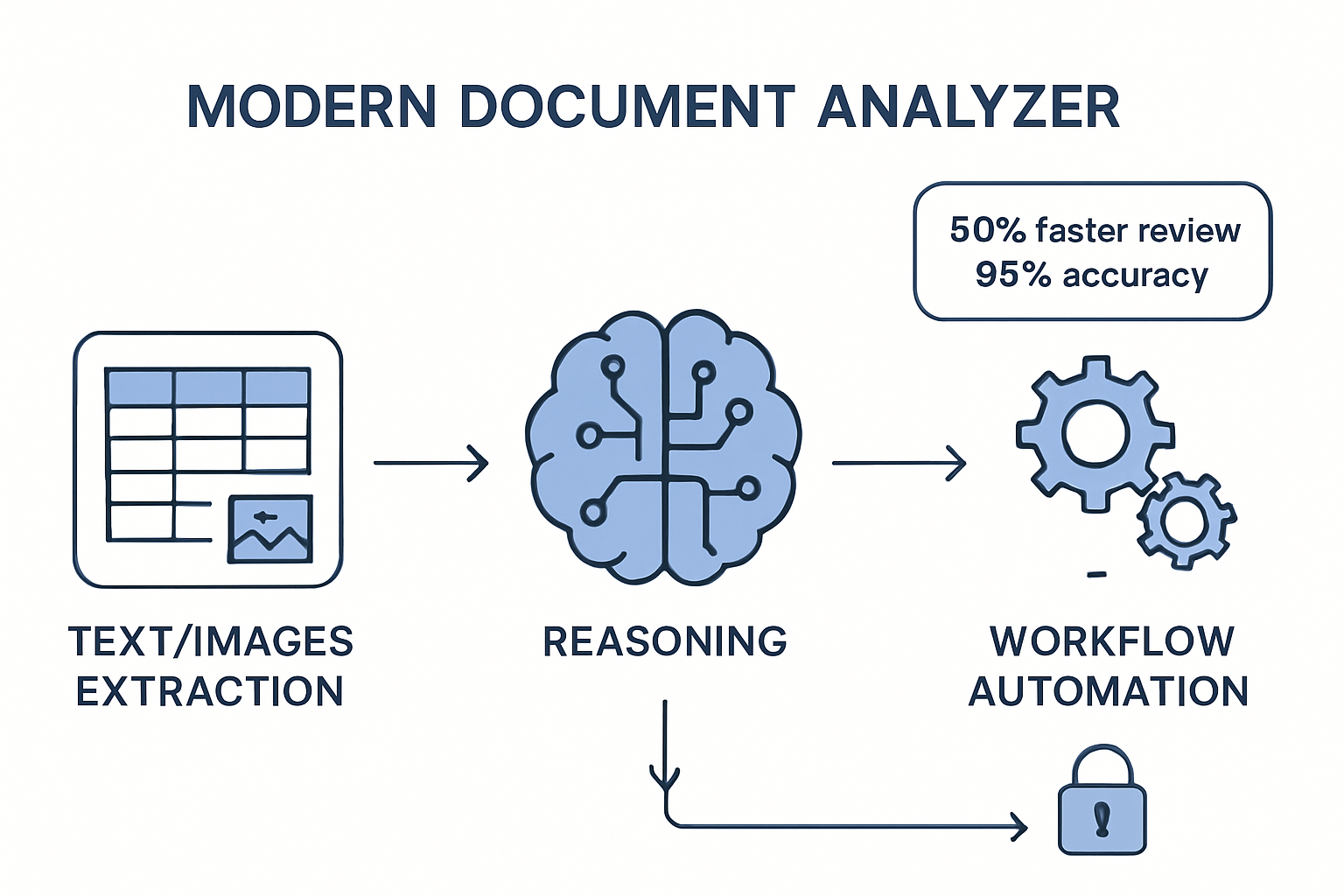
Intelligent Data Extraction and Classification
A document analyzer excels at extracting structured and unstructured data from a wide range of formats, including PDF, DOCX, images, and scanned files. AI-driven engines now recognize not just text, but also tables, images, and key entities—think contract clauses or financial data.
| Extraction Type | Example Use | Benefit |
|---|---|---|
| Text | Legal clauses | Fast review |
| Tables | Financial reports | Accurate totals |
| Images | ID verification | Compliance proof |
| Entities | Dates, names | Searchability |
What sets a modern document analyzer apart is its ability to automatically classify documents and their sections. AI models distinguish between invoices, contracts, and policies, then segment them into logical parts. This reduces manual sorting, minimizes errors, and accelerates onboarding for new document types.
For example, extracting a table of payment terms from a contract or identifying signature blocks in scanned forms becomes routine. The result: higher workflow efficiency, less risk of missed details, and consistent data quality.
Advanced Reasoning and Contextual Understanding
Beyond extraction, a document analyzer leverages natural language processing (NLP) to interpret meaning and intent. Instead of relying solely on keyword searches, semantic analysis uncovers relationships and context within the document.
Consider this simple NLP output:
Obligation Detected:
Party: Vendor
Action: Deliver quarterly reports
Deadline: 30 days after quarter end
Risk: High (penalty clause found)
This level of analysis allows a document analyzer to detect tone, flag legal risks, and even summarize key findings. For example, AI can highlight obligations, spot ambiguities, or surface sentiment in customer feedback surveys.
Semantic search means users can ask for "all payment deadlines" or "clauses about termination" and get precise results. This shift from basic search to contextual understanding drives smarter decisions and reduces manual review time.
Automation, Integration, and Workflow Optimization
A modern document analyzer automates repetitive processes that once required hours of manual effort. Batch processing lets users analyze hundreds of files at once, while automation rules handle classification, extraction, and routing.
Key integration benefits include:
- Seamless connection to document management systems (DMS)
- Real-time syncing with CRM, ERP, or case management platforms
- API support for embedding document analyzer features into custom workflows
These integrations translate into significant efficiency gains. For instance, organizations report up to 80% reductions in manual review time when using a document analyzer with automated workflows. Automated alerts, reminders, and report generation become standard, freeing professionals to focus on higher-value tasks.
Security, Compliance, and Audit Trails
Security is a fundamental pillar for any document analyzer. Today’s leading solutions feature robust encryption, granular access controls, and detailed audit trails to ensure every action is traceable and defensible.
Compliance is built in from the ground up. Whether you’re handling sensitive health data (HIPAA), personal information (GDPR), or financial records, a document analyzer enforces industry standards and regulatory requirements. Audit trails provide a transparent record of who accessed what and when, supporting both internal governance and external audits.
For deeper insight into privacy practices and security measures, review the Privacy and data security details adopted by top document analyzer platforms. These protections give organizations confidence to automate even their most sensitive workflows.
Step-by-Step: Mastering Smart Document Analysis
Unlocking the full power of a document analyzer in 2025 requires a deliberate, structured process. By following these clear steps, you can transform static files into actionable insights, streamline workflows, and reduce manual effort. Let’s break down the essential stages for mastering smart document analysis in your organization.
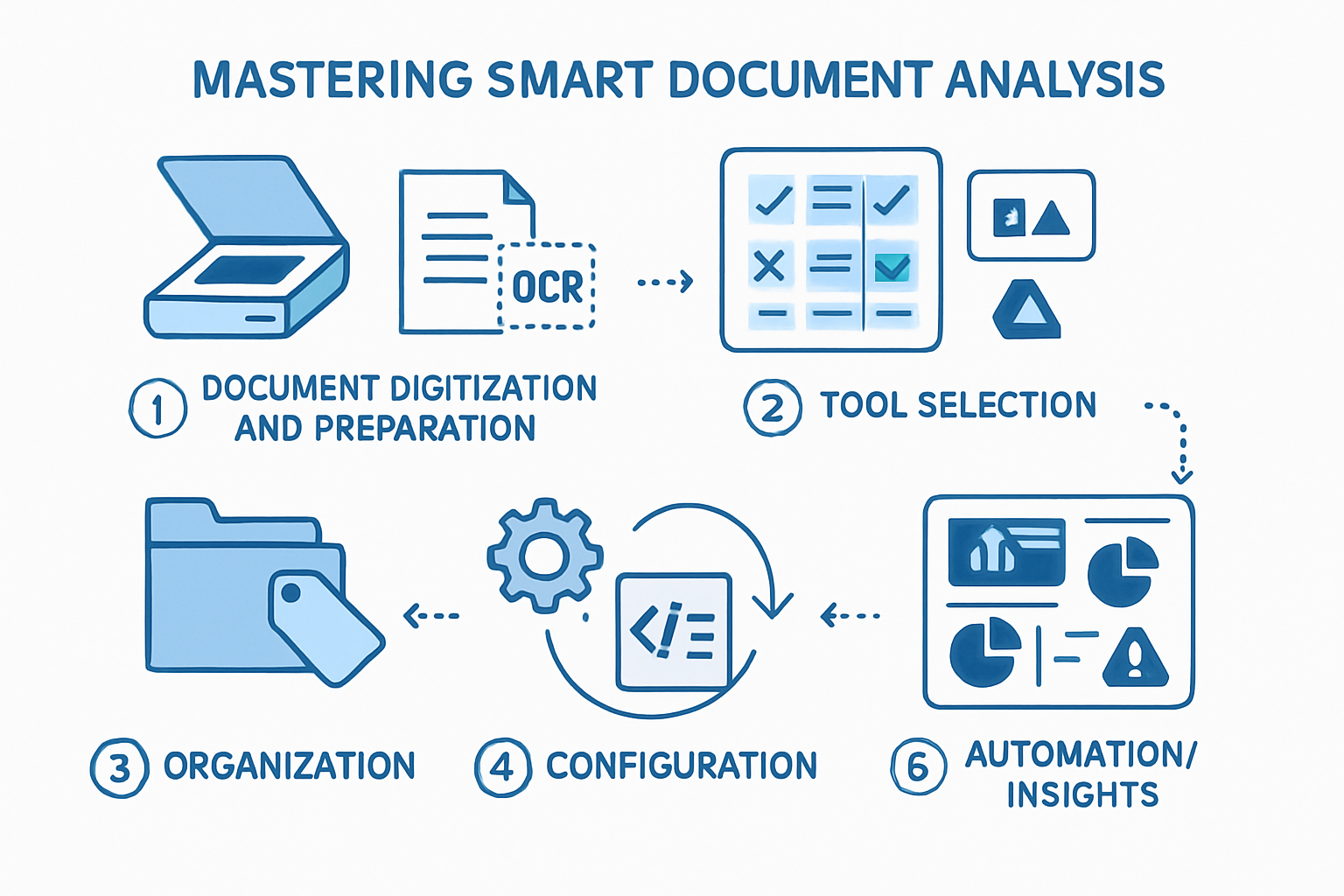
Step 1: Preparing Your Documents for Analysis
Before leveraging a document analyzer, ensure your documents are digitized and ready for processing. High-quality scans are essential—use a resolution of at least 300 DPI to improve OCR results. Avoid shadows, skewed pages, or handwritten notes that could confuse extraction algorithms.
Standardize file formats to PDF, DOCX, or other supported types. Consistent naming conventions and metadata tagging add vital context, making it easier for your document analyzer to identify and classify content later.
- Ensure all pages are legible and complete.
- Remove unnecessary blank pages or annotations.
- Store original and processed files separately for audit purposes.
Investing time in this initial step reduces errors and maximizes the effectiveness of your document analyzer.
Step 2: Selecting the Right Document Analyzer Tool
Choosing the right document analyzer sets the foundation for reliable, efficient analysis. Prioritize tools that deliver high accuracy, support a wide range of file formats, and offer advanced AI capabilities. Evaluate the user interface for clarity and ease of use, as intuitive design speeds up onboarding and daily operations.
Consider these criteria when comparing solutions:
| Criteria | Why It Matters |
|---|---|
| Accuracy | Reduces manual corrections |
| Speed | Enables faster processing |
| File Support | Handles diverse business needs |
| AI Features | Unlocks deeper analysis |
| Integration | Fits into your existing workflows |
| Support | Ensures help when you need it |
For example, OdysseyGPT AI document platform offers conversational querying, robust extraction, and seamless integration, making it a top choice for many professionals. Compare leading options side-by-side to identify which document analyzer aligns best with your workflow and compliance requirements.
Step 3: Uploading and Organizing Documents
Organized document management is crucial for efficient retrieval and analysis. Use clearly labeled folder structures reflecting project, client, or document type. Apply consistent naming conventions, such as “2025_Q2_Contract_ClientA.pdf,” to streamline search and batch operations within your document analyzer.
Tagging files with relevant keywords or categories (e.g., “NDA,” “Invoice,” “Research”) accelerates filtering and future audits. When uploading in bulk, confirm file size limits and supported formats to avoid processing delays.
- Batch upload related documents for unified analysis.
- Use tags to trigger automated workflows within your document analyzer.
A methodical approach here saves time and reduces risk of misplaced data.
Step 4: Configuring Analysis Parameters
Customizing your document analyzer’s settings ensures you extract the information you need. Define extraction rules based on your objectives—such as identifying contract deadlines, extracting financial tables, or highlighting key clauses.
Set up keywords, entities of interest, and output formats. For example, configure the document analyzer to generate executive summaries, export tables to Excel, or spotlight compliance risks.
- Choose between full-text extraction or targeted section analysis.
- Save custom templates for recurring document types.
- Test with sample files to validate output accuracy.
Fine-tuning these parameters tailors your document analyzer to your unique business needs and increases actionable insights.
Step 5: Reviewing, Validating, and Refining Results
Even the most advanced document analyzer benefits from human oversight. Review AI-generated outputs for completeness and accuracy. Check extracted data against the original files, focusing on critical sections like legal obligations or financial figures.
Establish a feedback loop where users can flag errors or suggest improvements. This iterative process helps refine the underlying AI models, ensuring your document analyzer becomes more precise over time.
- Validate random samples for quality assurance.
- Document edge cases or exceptions for future training.
- Update extraction rules as new document types emerge.
Continuous validation is essential for maintaining compliance and trust in your document analyzer’s results.
Step 6: Leveraging Insights and Automating Actions
The true value of a document analyzer lies in transforming extracted data into actionable outcomes. Export insights to reports, dashboards, or case management systems for decision-making. Set up automated alerts or reminders based on detected deadlines, obligations, or anomalies.
For instance, legal teams can automate compliance checks, instantly flagging missing clauses or expired terms. Batch processing and workflow integration can reduce manual review time by up to 80%, freeing staff for higher-value work.
- Schedule periodic analyses for ongoing monitoring.
- Integrate with downstream systems via APIs.
- Use analytics dashboards to visualize trends and risks.
By automating routine tasks, your document analyzer drives efficiency, accuracy, and strategic advantage.
OdysseyGPT: AI-Driven Conversational Document Analysis
OdysseyGPT stands at the forefront of next-generation document analyzer solutions, redefining how organizations interact with their documents in 2025. Unlike traditional tools, OdysseyGPT combines state-of-the-art AI with a conversational interface, allowing users to extract, interpret, and act on information with remarkable speed and accuracy.
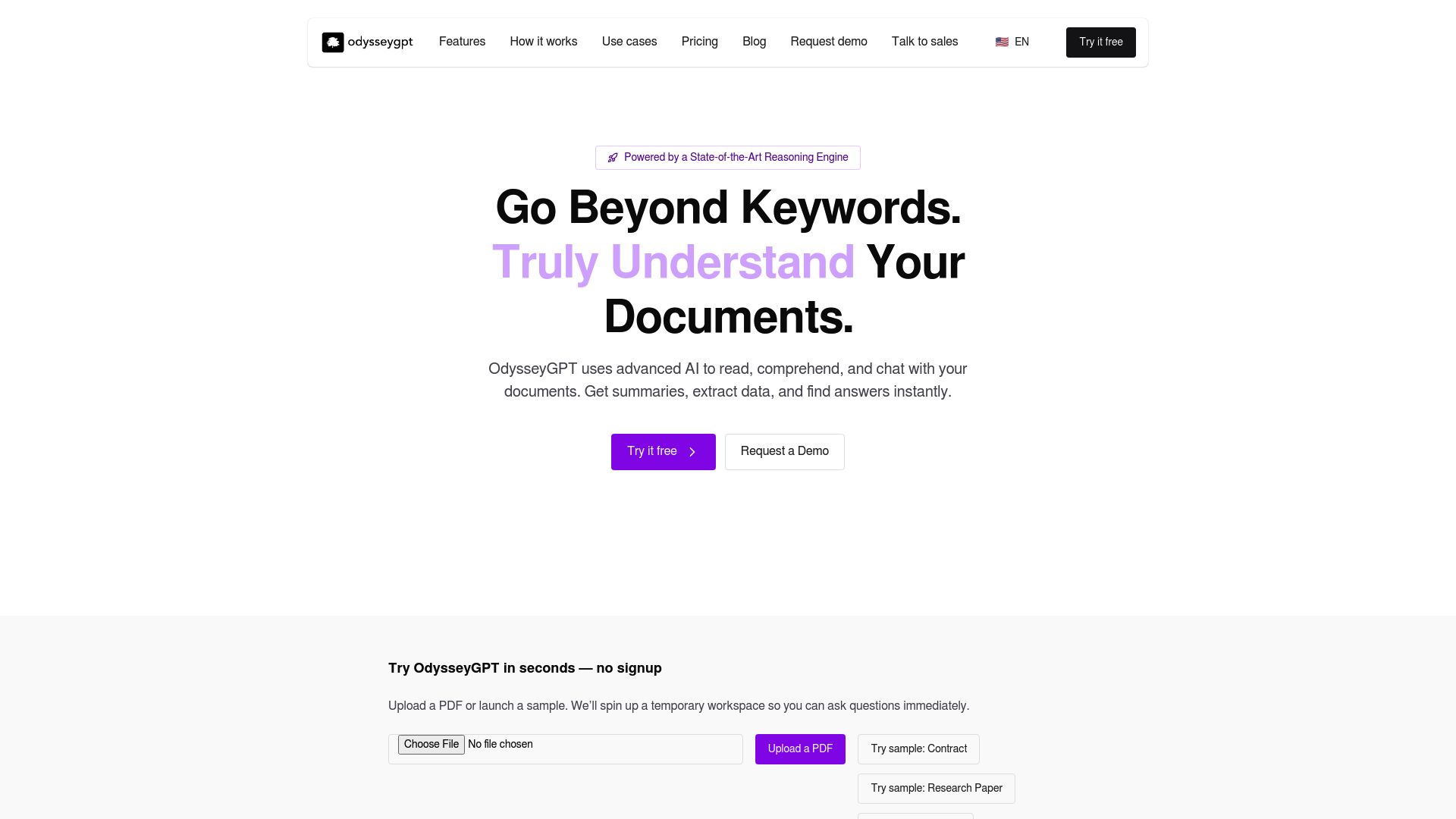
This platform transforms static documents into dynamic, searchable knowledge bases. Using advanced natural language processing, OdysseyGPT enables users to ask questions, summarize key points, and extract structured data from reports, contracts, or research papers. For a deeper look at its innovative capabilities, see the Introducing OdysseyGPT capabilities blog post.
OdysseyGPT’s document analyzer features support a wide range of industries and professionals. Researchers can instantly summarize academic articles and retrieve cited answers. Legal teams review contracts, extract obligations, and highlight case precedents without manual searching. Business analysts analyze financial reports and generate dashboards in seconds. Unique advantages include:
- 95% query accuracy—delivering reliable insights.
- 80% reduction in research time—freeing teams for higher-value tasks.
- Instant cited answers—with links to original sources.
- Secure, collaborative workspaces—for teams of any size.
A typical workflow involves uploading a legal brief, configuring extraction parameters, and using conversational queries to reveal obligations, deadlines, or case law references. OdysseyGPT’s document analyzer integrates seamlessly with existing systems, supporting batch uploads and automated exports to case management or analytics tools.
Security and compliance are foundational. OdysseyGPT provides end-to-end encryption and robust access controls, ensuring confidential data remains protected. Flexible plans are available for individuals, teams, and enterprises, with API access for custom integrations and workflow automation. This makes OdysseyGPT a future-proof investment for any organization seeking to unlock the full potential of their documents.
Top Document Analyzer Tools and Platforms in 2025
Selecting the right document analyzer in 2025 means understanding the landscape of AI-driven tools and platforms. With rapid advancements in artificial intelligence, document analyzers now offer deeper insights, seamless integration, and unmatched speed. Let’s break down the top solutions, industry-specific platforms, open-source alternatives, and key considerations shaping your decision.
Leading AI-Powered Document Analyzers
The document analyzer market in 2025 is led by platforms that combine AI reasoning, automation, and robust integration. Top contenders include Clio Duo, Microsoft Syntex, Kira Systems, and OdysseyGPT. Each delivers advanced text extraction, semantic analysis, and workflow automation.
| Platform | Key Strengths | Industry Focus |
|---|---|---|
| Clio Duo | Legal AI, clause extraction | Legal |
| Microsoft Syntex | Microsoft 365 integration | Business, Enterprise |
| Kira Systems | Contract review, risk | Legal, Finance |
| OdysseyGPT | Conversational AI, accuracy | Cross-industry |
Clio Duo stands out as a document analyzer tailored for legal professionals, while Microsoft Syntex is favored for its seamless integration with enterprise content. Kira Systems excels at contract analysis, and OdysseyGPT offers conversational querying with high accuracy.
For a deeper look at industry leaders and their market penetration, see the Document Processing Software Market Share report. Staying updated on this data helps organizations select the most reliable document analyzer.
Specialized Solutions for Industry Use Cases
Beyond general-purpose platforms, specialized document analyzer solutions target specific industry needs. In legal, contract review tools extract clauses and highlight obligations. Business-focused analyzers track KPIs and summarize financial reports. Academia benefits from research paper summarization, while healthcare relies on medical record analysis and compliance checks.
Examples include:
- Contract review platforms for legal teams
- Financial report analyzers for business intelligence
- Academic research summarization tools
- Medical record processing with regulatory compliance
The document analyzer market is shifting toward cloud deployment and AI integration, as highlighted in recent Document Capture Software Market Trends. This shift accelerates adoption in industries facing information overload and compliance pressures.
Open-Source and Customizable Options
Open-source document analyzer frameworks provide flexibility for organizations with unique requirements. Popular projects offer customizable pipelines for text extraction, entity recognition, and metadata tagging without licensing costs.
Pros:
- Full control over features and integrations
- Active developer communities
- Extensibility for niche workflows
Cons:
- Requires technical expertise for deployment and maintenance
- May lack advanced AI capabilities found in commercial tools
- Limited support compared to enterprise platforms
Open-source document analyzer solutions are ideal for research labs or tech-driven enterprises seeking tailored workflows.
Integration and API-Driven Platforms
Many document analyzer platforms in 2025 prioritize integration and automation. API-driven solutions allow seamless connection with document management systems, CRMs, and ERPs. This enables organizations to automate processes such as invoice processing, compliance monitoring, and data migration.
Key benefits:
- Streamlined workflow automation
- Consistent data flow across platforms
- Reduced manual intervention
For example, integrating a document analyzer API with a CRM system can automate the extraction of contract data, saving significant time and reducing errors.
User Experience and Support Considerations
Selecting a document analyzer goes beyond technical features. User experience, onboarding, and support are critical for adoption and long-term success. Leading platforms offer intuitive interfaces, guided setup, and comprehensive documentation.
Look for:
- Easy-to-navigate dashboards
- Interactive tutorials and training resources
- Responsive customer support channels
User feedback and adoption rates often reflect the quality of support provided. A document analyzer with strong onboarding ensures teams quickly realize value and maintain productivity.
The Future of Smart Document Analysis: Trends & Innovations
The landscape of document analyzer technology is rapidly evolving, setting new benchmarks for intelligence, collaboration, and security. In 2025, professionals across industries are witnessing a transformation in how information is extracted, synthesized, and acted upon. Understanding these trends is crucial for anyone aiming to maximize the value of a document analyzer in modern workflows.
Generative AI and Large Language Models
Generative AI is redefining what a document analyzer can achieve. In 2025, large language models (LLMs) empower tools to interpret context, summarize lengthy documents, and generate actionable insights. Unlike traditional keyword search, LLMs understand nuance, intent, and relationships between sections.
For instance, legal teams use document analyzer platforms powered by generative AI to create concise contract summaries, highlight obligations, and translate clauses between languages. This shift improves both speed and accuracy, enabling professionals to focus on higher-value tasks. As LLMs continue to mature, their integration into document analyzer solutions will only deepen, making advanced comprehension and summarization accessible to more users.
Cross-Document Intelligence and Knowledge Graphs
A modern document analyzer is no longer limited to single-file analysis. The emergence of cross-document intelligence allows these tools to link insights across multiple sources, building dynamic organizational knowledge bases. Knowledge graphs map entities, relationships, and events, connecting information that was previously siloed.
For example, law firms leverage document analyzer platforms to extract legal precedents from hundreds of case files, uncovering patterns and supporting stronger arguments. Businesses use similar techniques to aggregate performance metrics and trends from financial reports. This interconnected approach transforms static documents into living assets, fueling smarter decision-making at scale.
Real-Time Collaboration and Conversational Interfaces
Collaboration is at the heart of the next-generation document analyzer. Teams now expect to review, annotate, and discuss findings in real time, regardless of location. Advanced document analyzer solutions enable multi-user editing, shared comments, and version control, all within secure environments.
Conversational interfaces are also gaining traction. Users interact with the document analyzer through natural language queries, receiving instant, context-aware answers. Imagine asking, “What are the compliance risks in this contract?” and getting a clear, cited response. These features boost productivity by making document analysis intuitive and accessible to everyone on the team.
Enhanced Security and Privacy in AI Workflows
As organizations trust a document analyzer with sensitive data, robust security becomes non-negotiable. In 2025, privacy-preserving AI techniques such as federated learning and differential privacy are widely adopted. These approaches ensure data remains protected during analysis and model training.
Healthcare providers, for example, rely on document analyzer tools that comply with HIPAA and similar regulations. End-to-end encryption, strict access controls, and detailed audit trails are now standard. By prioritizing security, document analyzer vendors help organizations meet regulatory requirements and prevent breaches in high-stakes environments.
Industry-Specific Innovations and Use Cases
The document analyzer is increasingly tailored to specific industries, driving automation and compliance. In law, custom AI models automate due diligence, flag risks, and check regulatory clauses in contracts. Financial firms use advanced document analyzer tools to extract KPIs, automate reporting, and support real-time audits.
Education and healthcare sectors are also benefiting. Academic researchers utilize document analyzer solutions to synthesize literature, while hospitals automate the review of medical records for improved care and compliance. Flexible pricing and deployment options, as outlined in OdysseyGPT pricing and plans, make these innovations accessible to organizations of all sizes.
Market Outlook and Adoption Statistics
The demand for a sophisticated document analyzer continues to surge. According to recent Document Management Software Market Analysis, the market is projected to grow significantly through 2030, driven by digital transformation, remote work trends, and complex regulatory landscapes.
Adoption rates are especially high in sectors handling large volumes of sensitive or regulated data. Key drivers include the need for workflow automation, improved compliance, and actionable intelligence. As document analyzer solutions become smarter and more integrated, organizations are poised to unlock unprecedented value from their information assets.
If you’re ready to transform how you interact with documents—moving from manual searching to intuitive, AI-powered insights—now is the perfect time to take the next step. With OdysseyGPT, you can harness advanced conversational analysis, structured data extraction, and real-time collaboration to make your document management seamless and future-proof. Whether you're in law, business, academia, or education, the right tools can dramatically boost your efficiency and accuracy. Why not experience firsthand how intelligent document analysis can elevate your work in 2025?
Start free trial

